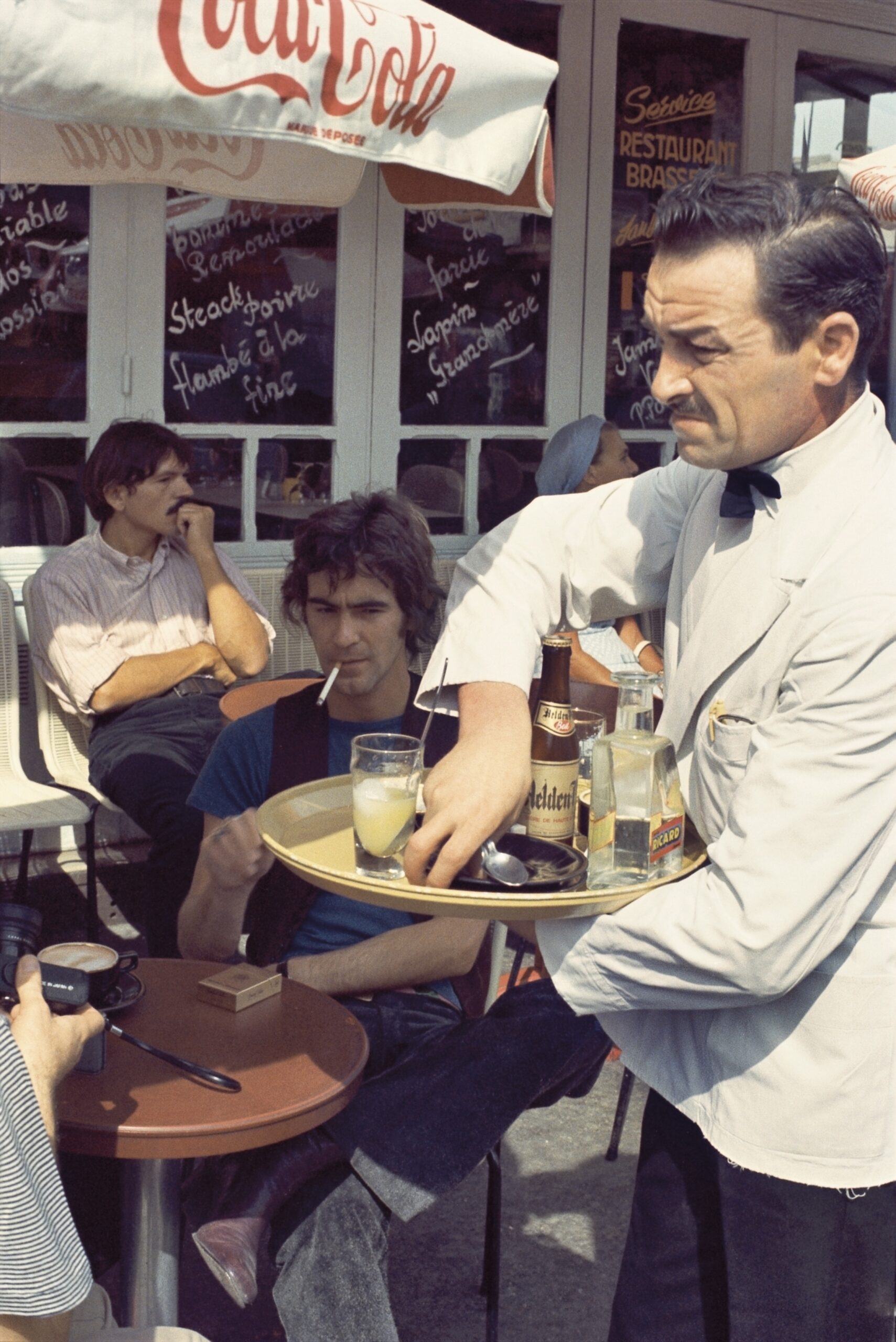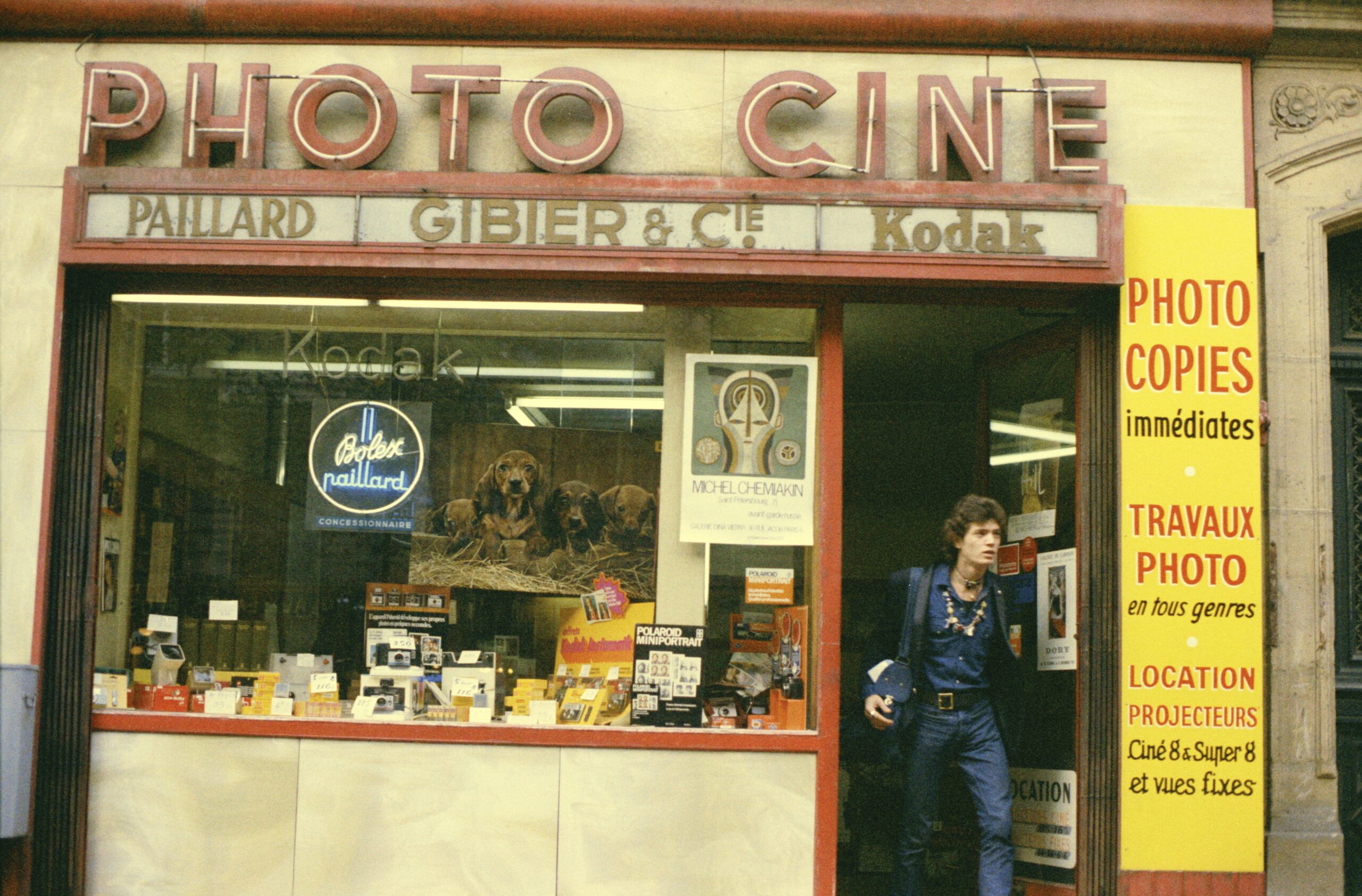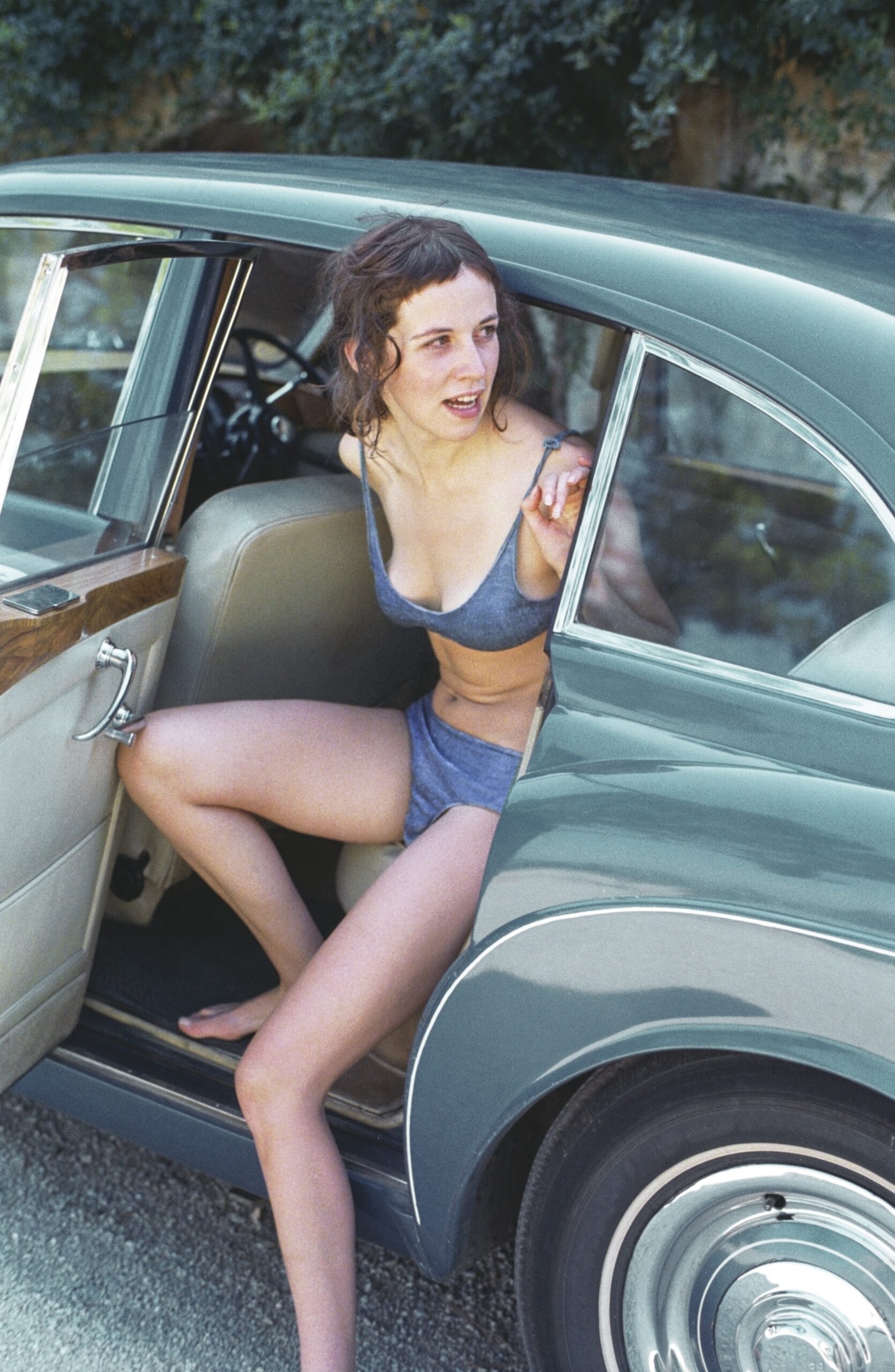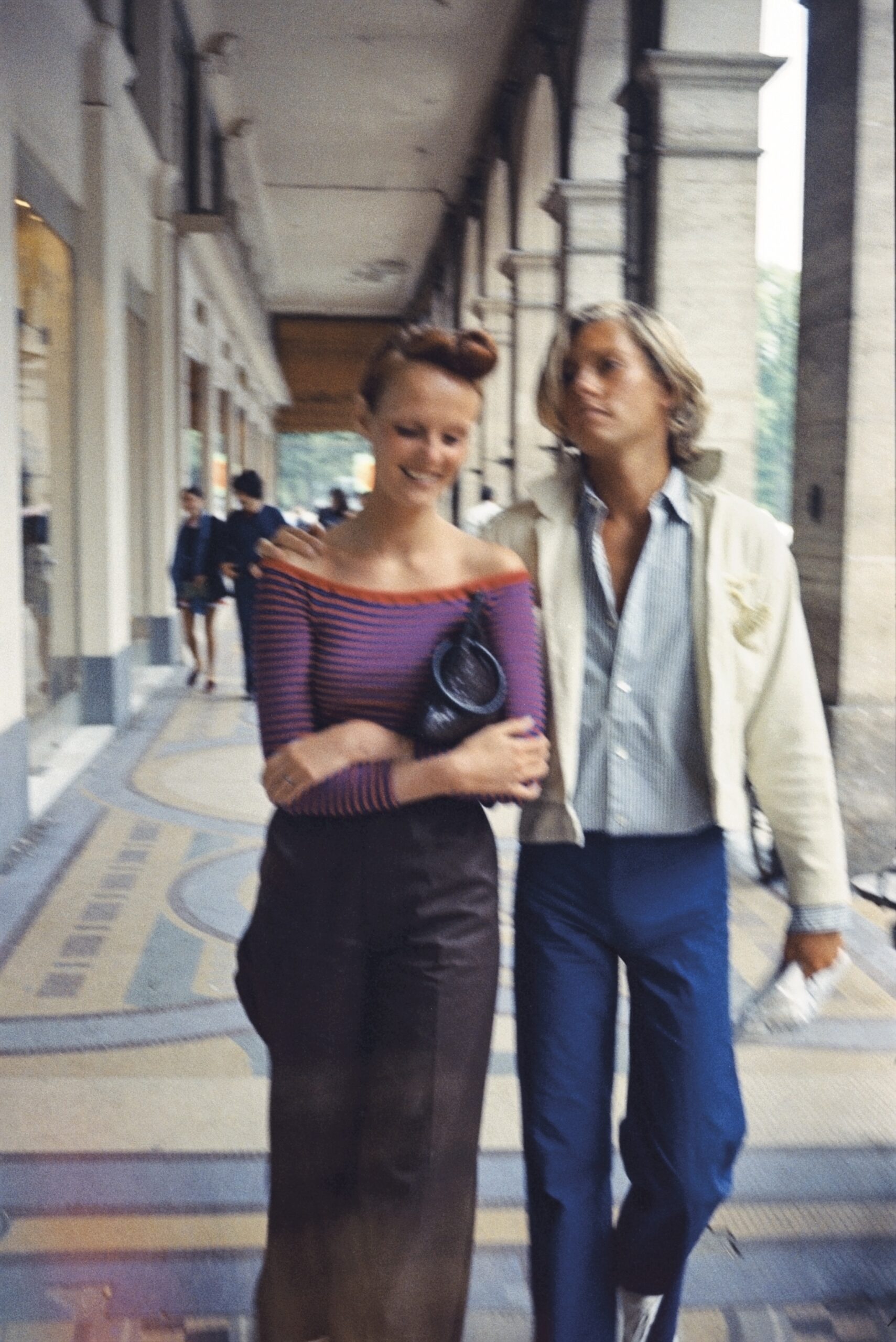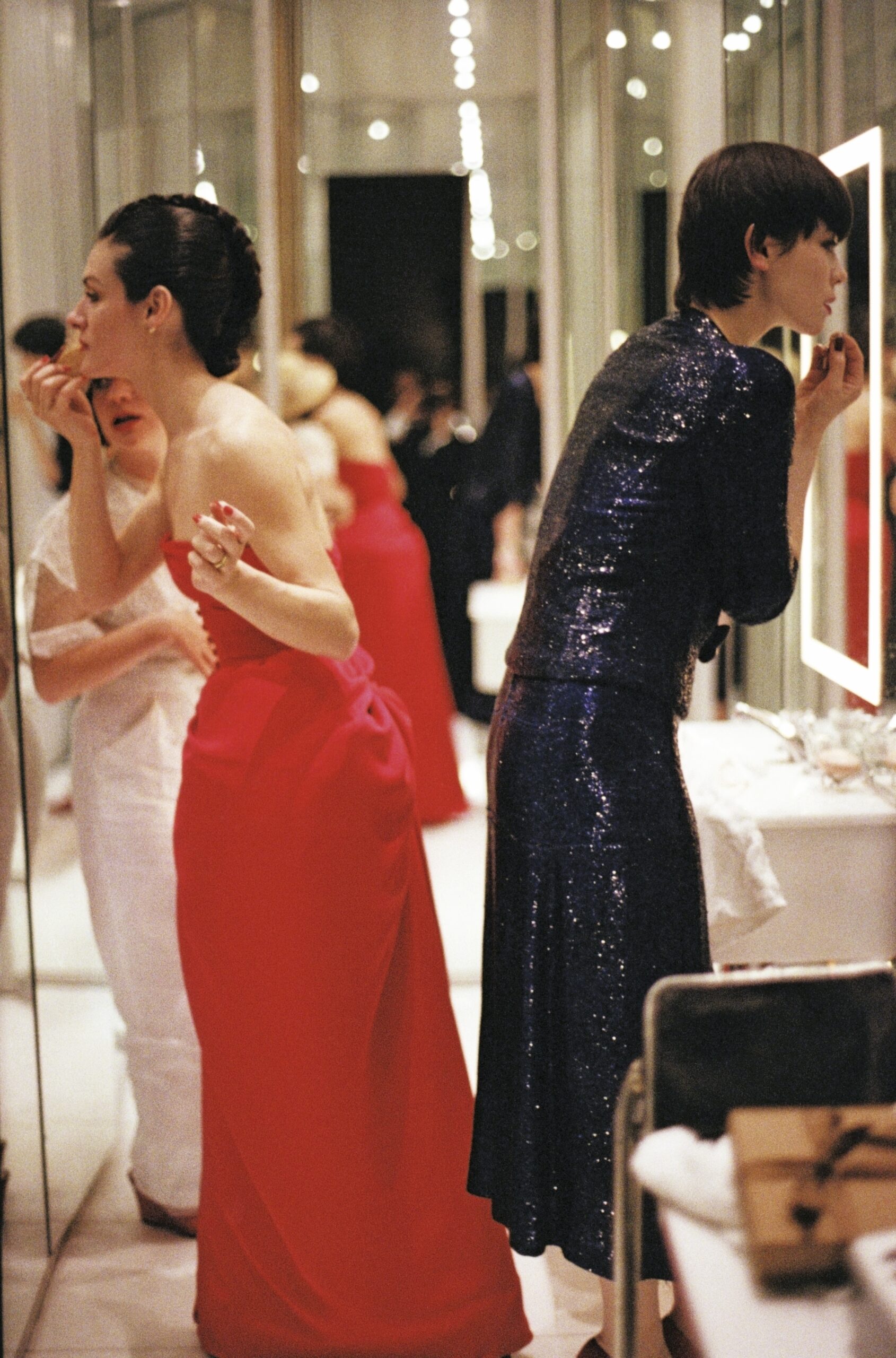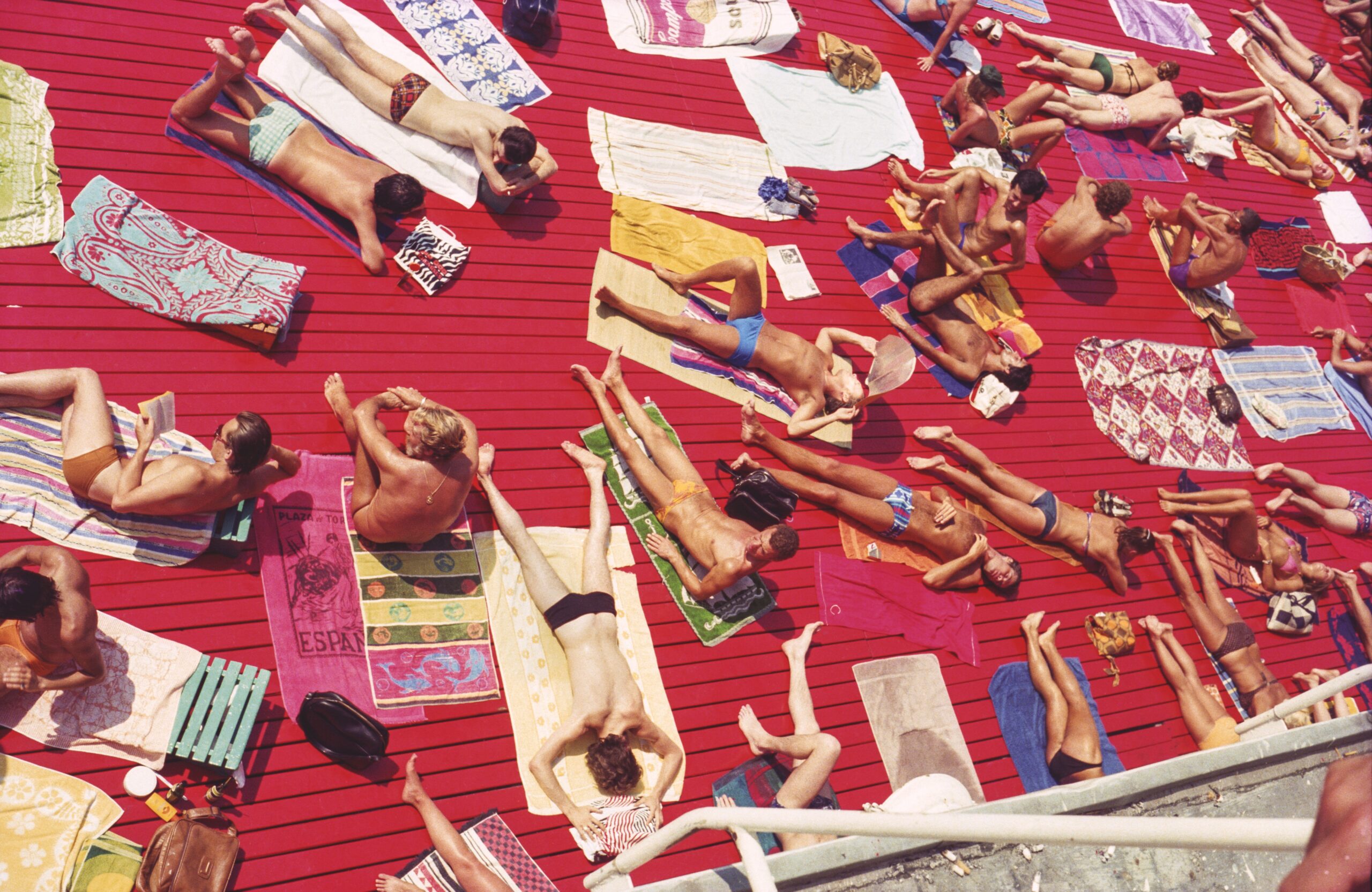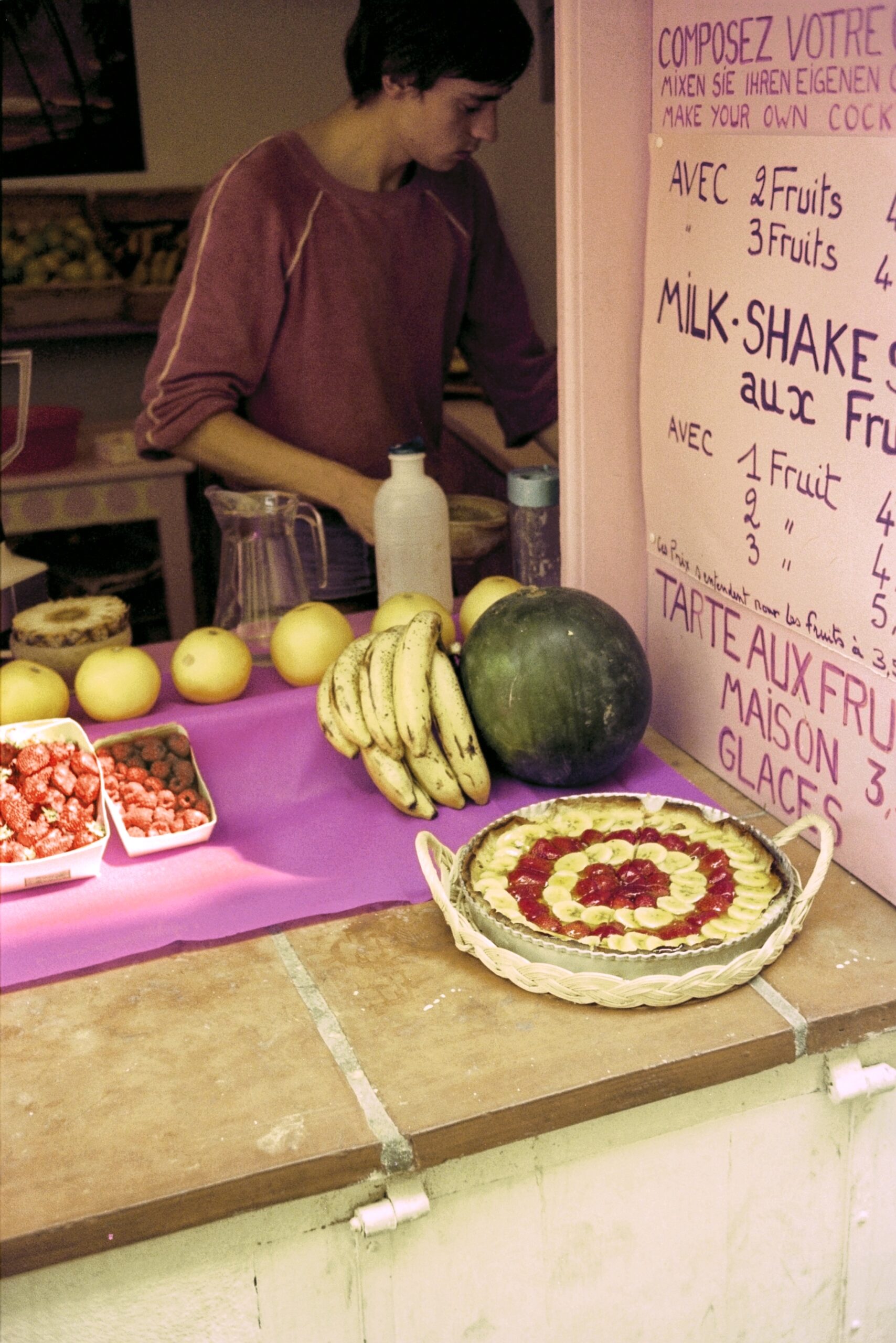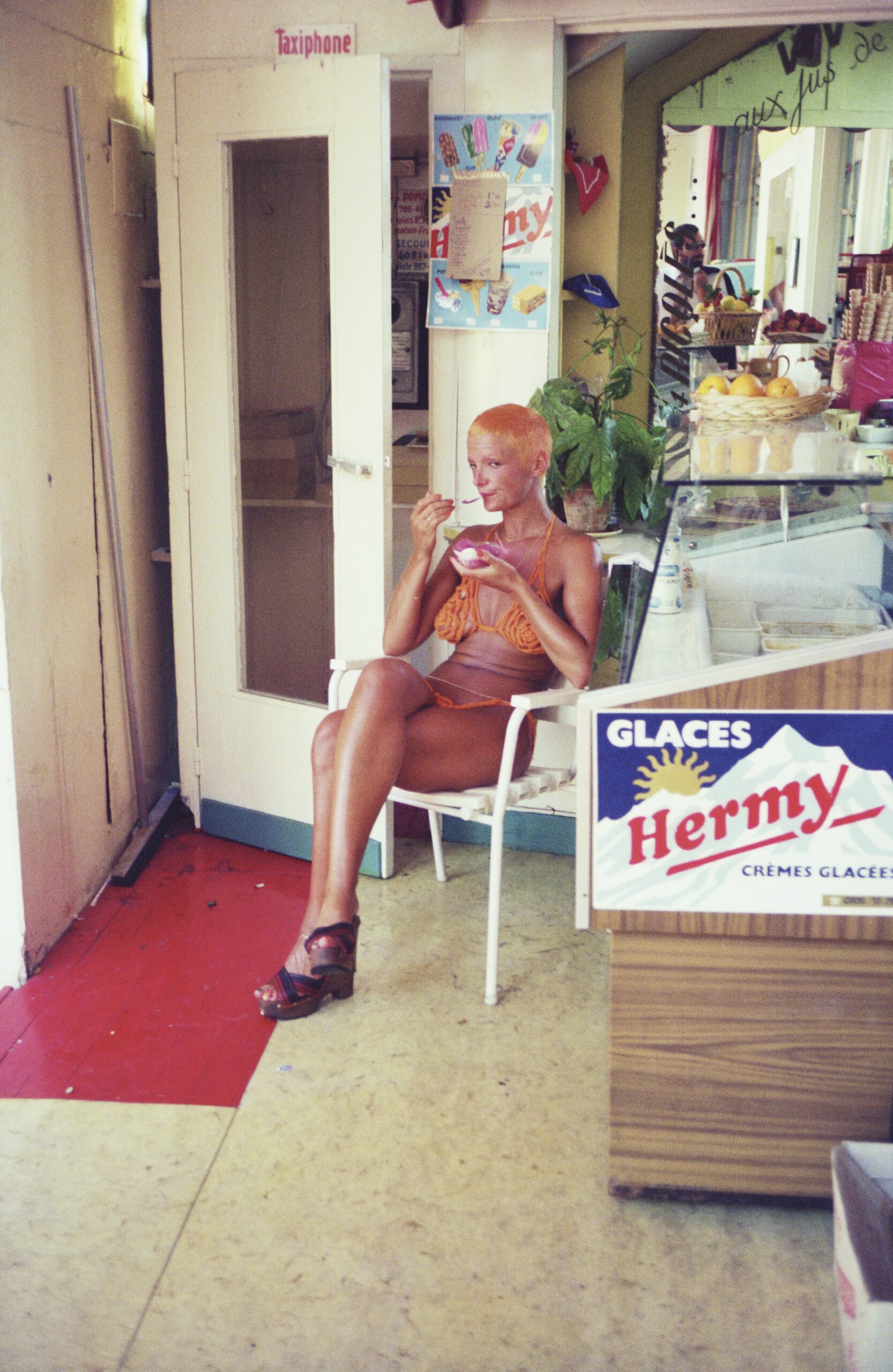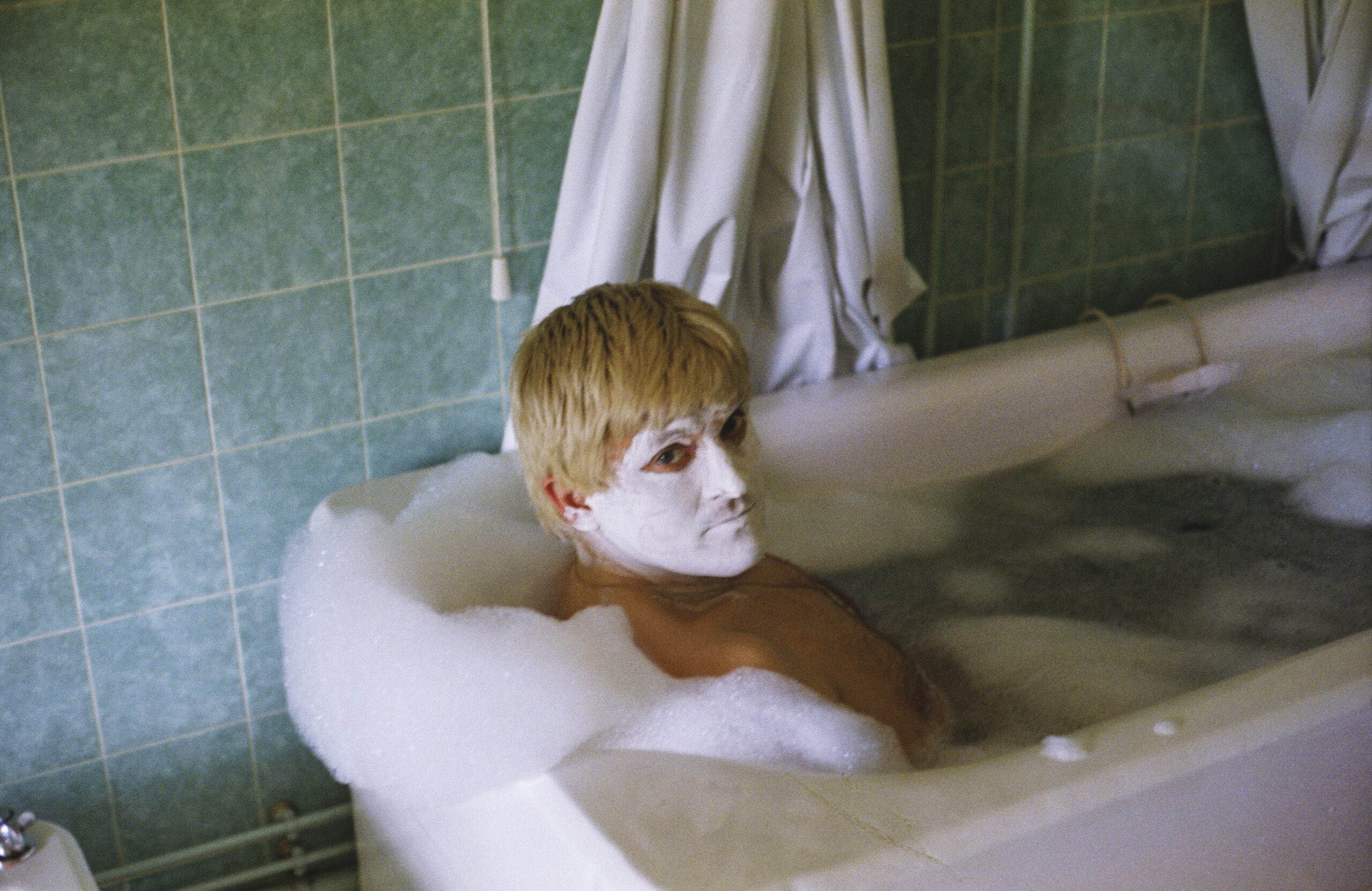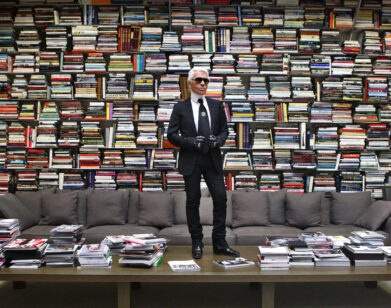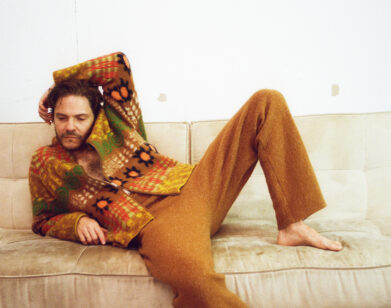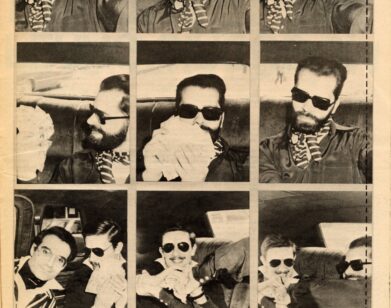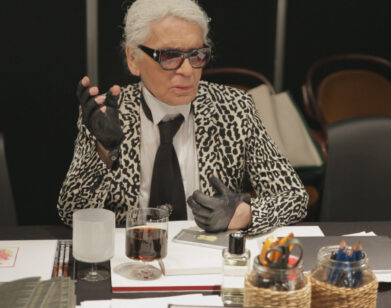seventies
Peter Schlesinger and Manolo Blahnik Look Back on the Golden Age of Paris
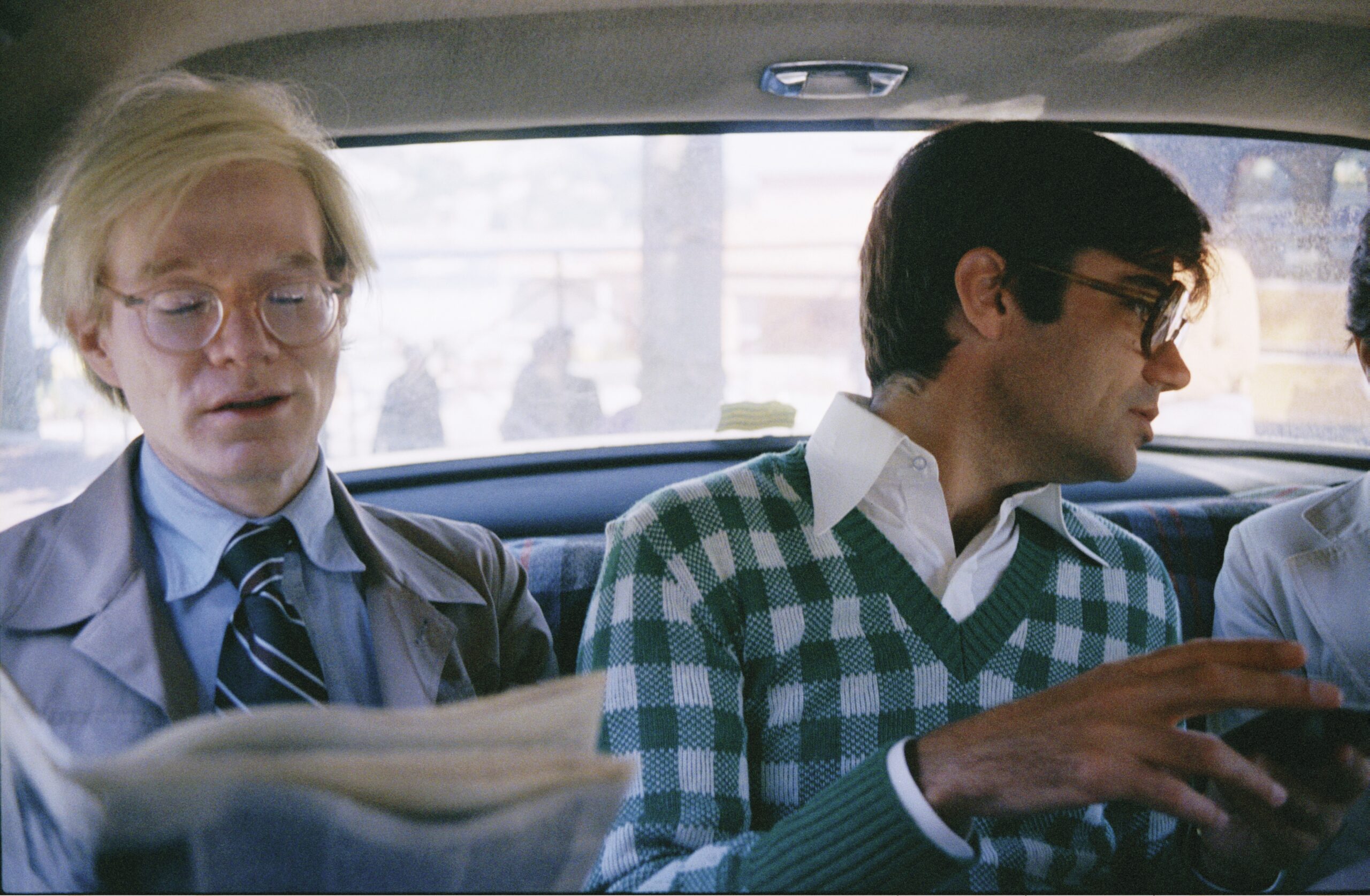
Andy Warhol and Rex Reed in a Taxi, Monaco, 1974. All images by Peter Schlesinger, courtesy Mariposa Gallery.
With a mop of auburn hair and face full of freckles, Peter Schlesinger brought his Beach Boy charm to London in the late 1960’s, abandoning the sun-drenched pools of Los Angeles when he moved across the pond with his then-boyfriend David Hockney. Schlesinger met the British artist in 1966 when he was still a student at UCLA and relocated to Europe with him soon after. Swept up in a transatlantic love affair, the doe-eyed Schlesinger, then in his early twenties, gained entry into a Kool Aid-colored life that was just as vibrant and eclectic as Hockney’s paintings. Luckily for us, he brought a camera along with him.
Last month, Mariposa opened its doors to Peter Schlesinger, France: 1969 – 1979, the inaugural exhibition at the Paris-based gallery. Spilling like a jewel box onto Rue de Turenne, the show, which is open through November 25th, unravels a decade of Schlesinger’s snapshots in cities like Saint Tropez, Paris, and Monaco. To unpack his past, Schlesinger logged onto Zoom to have a very modern conversation with his old friend, the marvelous footwear impresario Manolo Blahnik, to look back on the golden age of Café de Flore, French snottiness, and the time Anna Piaggi caught fire at Paloma Piccaso’s wedding.—MITCHELL NUGENT
———
PETER SCHLESINGER: Hello?
MANOLO BLAHNIK: My goodness gracious. I’ve been waiting for half an hour. I can’t take it any longer.
SCHLESINGER: I know. Anyway, I can show you some of the photographs that are in the exhibition, and we can just talk about them.
BLAHNIK: Certainly.
SCHLESINGER: Do you see that? Ossie [Clark] at the Café de Flore. Your first shoes were with Ossie?
BLAHNIK: Yes, I did them for the show at the Royal Court. That was an incredible time, because everybody would go to Paris and the first thing they did was go to Flore.
SCHLESINGER: Absolutely. Whoever was in town, you’d see them there. Now it’s a tourist trap with lines of tourists waiting to get in.
BLAHNIK: Now it’s full of horrible people, yes. I remember at the beginning of the ’60s, you’d go there and see men with ponytails and things. It was nothing to do with later on.
SCHLESINGER: The picture’s called “The Angry Waiter,” because the French waiters were always nasty.
BLAHNIK: Oh, the French waiters at Flore were nasty beyond belief all the time. I don’t know where they came from.
SCHLESINGER: Apparently people are nicer in Paris now.
BLAHNIK: They’re trying hard to get a better reputation.
SCHLESINGER: Do you remember Shirley Goldfarb used to sit inside Flore—
BLAHNIK: Café Flore used to be Shirley Goldfarb. She was there from 1960 up until she died, every day.
SCHLESINGER: She spent her life there.
BLAHNIK: Even if you didn’t know her, you’d still say, “Let’s go and talk to Shirley,” because she was very amusing. And I loved her makeup, completely like Lila Kedrova in Torn Curtain, the Hitchcock movie.
SCHLESINGER: This is on the Boulevard Saint-Germain and that’s Robert Mapplethorpe coming out of the shop.
BLAHNIK: He was very clean and put together that day. Poor Robert.
SCHLESINGER: This is the daughter of Richard Hamilton, Dom Hamilton.
BLAHNIK: My god, she had wonderful legs, that girl. Where is that, in Paris?
SCHLESINGER: That’s in the south of France, at Mick Jagger’s. That’s Ossie’s Bentley when I eloped with Eric [Boman] across France.
BLAHNIK: I remember you traveled in that Bentley.
SCHLESINGER: It was the most beautiful car.
BLAHNIK: It’s a beautiful color. I adore that period, really, all the people. Who’s that?
SCHLESINGER: That’s Eric and Grace Coddington.
BLAHNIK: Good lord, Grace’s hairdo is incredible. She always managed to look very modern, Grace. She was so beautiful. She’s still beautiful, but she had an incredible style.
SCHLESINGER: It’s outside Angelina.
BLAHNIK: Angelina! That was my place continuously. Lunch, dinner, everything. You met everybody without even going anywhere. It was fantastic.
SCHLESINGER: Did you have hot chocolate?
BLAHNIK: Yes, I got hot chocolate. It was wonderful.
SCHLESINGER: I went with what’s-her-name from Saint-Laurent… Clara Saint.
BLAHNIK: Clara was always fantastic in groups. She was always with groups of Argentinians or this or that, but she was very professional. Always working, working, working. I have incredible memories of that period in Paris. It was really like a small town. You just walked down the street and you knew everybody. And Rex Reed, my god! Is he alive, Rex Reed?
SCHLESINGER: Yeah, he is, actually. I haven’t seen him in 40 years, but he’s alive.
BLAHNIK: Is he well?
SCHLESINGER: I think he’s okay.
BLAHNIK: Oh my god, La Piscine Deligny! I’ve only been once, and I didn’t even touch the floor, because I was scared to get something horrible. It was so filthy. It was very smelly.
SCHLESINGER: [Laughs] They used to sit there every day. This is at the Piscine also.
BLAHNIK: It was just horrible! I didn’t like it very much.
SCHLESINGER: [Laughs] This is in Saint-Tropez.
BLAHNIK: Oh, beautiful. That’s a different town.
SCHLESINGER: Oh, here is Tina [Chow] and Paloma [Picasso].
BLAHNIK: That is a famous photograph during the wedding at Karl Lagerfeld’s house! I remember that day. Karl Lagerfeld and Anna Piaggi had this huge hairdo with feathers and she caught fire, and people were like, “Oh my god,” and she was like, “Oh, I don’t mind at all.”
SCHLESINGER: Yes. It was from an opera costume, I think.
BLAHNIK: She had passed through the chandeliers, and the chandeliers were all real candles at Karl’s all the time.
SCHLESINGER: It was all candlelit, yeah. Did you go to that apartment very much?
BLAHNIK: All the time. Karl was incredible with me. You know why? Because he knew that I didn’t give a damn about all these people in Paris. I was visiting. I actually had a wonderful moment with him once, he was so sweet when Jacques [de Bascher] died. He said to me, “Come over. Have tea with me.” We spent all afternoon talking and he explained to me how he adores Jacques, so it was a very moving moment. I saw Karl when he had parties as well. He always invited me.
SCHLESINGER: What years did you live in Paris?
BLAHNIK: Beginning of the ’60s. One of the first times I went to Paris, I was in Geneva in university, and we were desperate to see Dommage qu’elle soit une putain, or Pity She’s A Whore, the play directed by Visconti. It’s an Elizabethan tragedy with Romy Schneider and Alain Delon. We bought tickets to the Théâtre de Paris and we traveled in a Citroën 2CV. Oh my god, it was uncomfortable. We arrived in Paris and I checked into this mangy hotel in Saint-Germain. There we tried to fix ourselves, and we went to see Romy Schneider. It was far away, but I grabbed this lady and I said I need to see better because I’m blind, and boom, I watched Alain Delon and Romy Schneider, who were, to me, the most beautiful people in Europe at the time, playing the incestuous brother and sister. It was fantastic.
SCHLESINGER: What made you go from Paris to London?
BLAHNIK: Because Paris became too small, somehow. It was just Saint-Germain, home, Saint-Germain. I got bored. And in 1968, all these people were in the street burning cars, which was absolutely frightening. I decided I’d prefer to be in London, and I came to London in 1970.
SCHLESINGER: When I was just in Paris, I realized that when I used to go there before, I was only ever in Saint-Germain. That’s the only place I ever went to.
BLAHNIK: It’s the only place that everybody used to go, because there was fun all the time. Paris had beautiful, glamorous people like Peggy Roche, Françoise Sagan, Charlotte Aillaud. Those were my people.
SCHLESINGER: I’m going on Monday night to see Caroline Loeb play Françoise Sagan in a play.
BLAHNIK: You told me the other day. Is she good?
SCHLESINGER: I think yes.
BLAHNIK: There was a film about Françoise which was fantastic, actually. But these were the people I saw almost every day. I was absolutely mesmerized by the beauty of Peggy Roche.
SCHLESINGER: I didn’t know Peggy Roche.
BLAHNIK: She was the editor of Elle and many other things. All these women were very beautiful and incredibly chic. They encapsulate French people.
SCHLESINGER: Did you know Colombe Pringle?
BLAHNIK: I knew her but later on. She was so incredible, and her mother was an extraordinary woman, too. Everybody in France at the time was producing things. It was totally different from now.
SCHLESINGER: Colombe was very close to Paloma at that time. They have the same birthday.
BLAHNIK: Today is Anna Wintour’s birthday. I just sent her flowers.
SCHLESINGER: It is? Oh my god. I’d better send her something. Yeah, when Eric was in Paris, Paloma and Colombe flew to Paris before him so they could meet him at the airport without him knowing. They told me the other day.
BLAHNIK: [Laughs] Eric was incredible. All those girls in Paris were just mad about Eric. I never liked what Eric projected, but he was a beauty, no matter what. I remember the first time I saw Eric in London, he was waiting for the bus with a little bag and this incredible aura. I was taking a picture of somebody, and I just attacked him in the street. I said, “Hello, I want to know you.”
SCHLESINGER: You invited him to a party, and when he got there, he was the only person there. [Laughs]
BLAHNIK: No, I invited him to a party, and then I realized that it was the wrong day, and I only had French beans and rice.
SCHLESINGER: That’s all you ever had, and daiquiris.
BLAHNIK: Daiquiris. I always had daiquiris. That’s the only thing I knew how to do.
SCHLESINGER: With rice and beans.
BLAHNIK: Rice and beans and daiquiris. How do you remember that?
SCHLESINGER: I remember up in Colville Terrace when you were upstairs from me.
BLAHNIK: I didn’t have much talent on the cooking side at the time.
SCHLESINGER: And Tiptree jam.
BLAHNIK: Tiptree jam always. I still have it. Not anymore, because I just got this terrible problem with diabetes.
SCHLESINGER: Well, you lived on sugar.
BLAHNIK: Oh god, I lived on chocolate and sugar my whole life. I have to eat this Nestlé chocolate with zero sugar now. What exactly are we doing here?
SCHLESINGER: We’re supposed to be talking about my photographic exhibition in Paris.
BLAHNIK: The exhibition is a great success, but my favorite picture is not there, which is the table of Madame Rothschild. I adore that picture. It’s my favorite picture of yours ever.
SCHLESINGER: She had died a year earlier, but Baron Philippe de Rothschild kept everything like it was when she was alive. She still entertained and set the table.
BLAHNIK: I used to deliver to her on Vigo Street. Her apartment in the Albany was not very big, but beautifully done.
SCHLESINGER: You went into her apartment?
BLAHNIK: To deliver the shoes. She bought flat shoes. This was the last two or three years of her life. The people that used to live there—Fleur Cowles, John Richardson—all these people are dead, unfortunately. Even Christopher Gibbs.
SCHLESINGER: Fleur Cowles had a huge apartment there. Hers was the biggest one in the Albany.
BLAHNIK: Christopher Gibbs had the top two floors. Very nice.
SCHLESINGER: I never quite understood it. It’s very central, but it had some sort of romance to it, didn’t it?
BLAHNIK: Lord Byron used to live there, and it had that historical fantasy.
SCHLESINGER: What is Bond Street like, does it still have a flavor of what it used to have?
BLAHNIK: No, it’s like Milan or Hong Kong. It’s just Gucci and Pucci everywhere. There’s nothing English left like Bill’s. I remember buying those huge jackets at Bill’s.
SCHLESINGER: I used to get my photo albums from a photo shop called Wallace Heaton in—
BLAHNIK: Wallace Heaton! I don’t think it’s there anymore. I still have about 40 albums.
SCHLESINGER: Nobody takes photographs anymore. It’s all on your telephone.
BLAHNIK: “Oh, I have it in the cloud.” I say, “What?” I still love albums. I’m very old-fashioned.
SCHLESINGER: Me too. I must say, I don’t have the photographs printed anymore.
BLAHNIK: I do. If I really like a picture, I have it printed.
SCHLESINGER: Wow, I should do that. Do we have any other memories from France in the ‘70s?
BLAHNIK: Oh god, if I keep talking about the ’70s, it’ll be five weeks long. What I really wanted to say about this time in Paris that you photographed so well is that when you look at those pictures, you’re there again. That’s what happened to me. It’s very strange. I looked at your book, A Checkered Past. I adore it. I remember even the smell of the rooms when we took the pictures. This is what old pictures do to me. I hate nostalgia, but I revive those moments when I see the pictures. Isn’t it extraordinary?
SCHLESINGER: It is.
BLAHNIK: The other day I watched À bout de souffle. It was incredible. Jean Seberg and Jean-Paul Belmondo. There’s something that I never thought I would say, but I will say now with a certain authority—Godard did not stay fresh in my mind like they used to somehow, but Visconti, Rocco and his brothers, they’re so divine. It’s so well-observed. Everything is beautifully done. I miss people like that. Of the French people, only a few survived that I love very much of that period. Catherine Deneuve and Françoise Dorléac.
SCHLESINGER: Jean-Pierre Melville.
BLAHNIK: Divine.
SCHLESINGER: They held up. The Godards don’t hold up. The Jean-Pierre Melvilles do.
BLAHNIK: French actors disappeared quite quickly, apart from my eternal love, Isabelle Huppert. She’s so crazy, and I love her very much.
SCHLESINGER: Some of them just go on forever and ever, don’t they?
BLAHNIK: Catherine works five films a year. The other day I saw a film of hers called La vie de Bernadette Chirac, extraordinary. You cannot imagine that she is my age.
SCHLESINGER: We’ll sign off and talk again soon. We should try to Zoom more often. It’s nice to Zoom instead of the telephone.
BLAHNIK: I don’t like Zoom very much. Can I talk to you on the telephone? These technical difficulties, god, it was terrible.
SCHLESINGER: All right.

